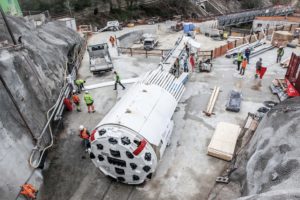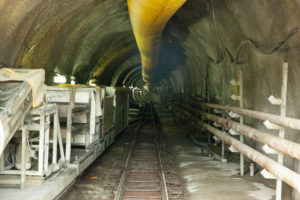![65 Years of Innovation and Experience [default]](https://www.robbinstbm.com/wp-content/uploads/2017/04/Side-Bar-Blue-Blocks_70-Years.jpg)
A Solution for Every Condition: Search our Project Database
Project Map
FEATURED PRODUCT: CROSSOVER MACHINES
Our History
A Legacy of Innovation
Information 24/7
News & Media
Insights in the Industry:
Read the Robbins Blog
Galerie des Janots is one of the fourteen operations designed to save water and protect resources, which were carried out by the Aix-Marseille-Provence metropolis, water agency Rhône Mediterranean Corsica, and the French State Government. The Janots gallery improved access to water in communities east of the Aix-Marseille-Provence  metropolis (Cassis, Roquefort-la-Bédoule, La Ciotat and Ceyreste). The pipeline replaced existing pipelines—located in a railway tunnel—which had significant safety and vulnerability deficiencies with estimated water losses of 500,000 cubic meters (17.7 million cubic ft) per year. The prior pipes had a capacity limited to 330 liters (87 gal) per second, which was largely insufficient in the summer season. The objective of the Galerie des Janots operation was to increase capacity to 440 liters (116 gal) per second.
metropolis (Cassis, Roquefort-la-Bédoule, La Ciotat and Ceyreste). The pipeline replaced existing pipelines—located in a railway tunnel—which had significant safety and vulnerability deficiencies with estimated water losses of 500,000 cubic meters (17.7 million cubic ft) per year. The prior pipes had a capacity limited to 330 liters (87 gal) per second, which was largely insufficient in the summer season. The objective of the Galerie des Janots operation was to increase capacity to 440 liters (116 gal) per second.
The tunnel passes under Le Parc National des Calanques with cover between 15 m (49 ft) and 180 m (591 ft). Geotechnical studies of the area showed that the 2.8 km (1.7 mi) long tunnel was shown to have limestone, groundwater, and both filled and empty karst cavities. One of the biggest challenges faced by the excavation was two uncharted caverns; the largest of the two measured a staggering 8,000 cubic meters (283,000 cubic ft) in size.
On March 3, 2017, the 3.5 m (11.5 ft) diameter Robbins TBM, christened “Augustine”, was commissioned. This TBM was extensively modernized and upgraded during the rebuild for the Galerie des Janots project in La Ciotat, France. At 250 metric tons (276 t), and 135 m (443 ft) long, the TBM and backup system could not fit at the small jobsite adjacent to residences and other buildings. Very little on-site storage was allotted in the launch area, with just 25 m (82 ft) outside the portal for assembly, which was the exact length of the TBM from the head to the rear legs. This made the logistics of the machine arriving in sequence and being assembled on time vital.
The crew did a two-stage assembly for the machine, first assembling the TBM and five decks of the backup system, with the remaining decks afterwards. After assembly, the crew launched the machine, working 24 hours daily to excavate the tunnel and maintain equipment during the bore.
When the machine launched, optimism was the crew’s mindset about getting through the karstic limestone obstacles. While limestone itself is easy to maneuver through, challenges emerged with the karst. For this project, the TBM was equipped with a probe drill, and to further identify cavities ahead of the TBM the crew installed a geotechnical Bore-tunneling Electrical Ahead Monitoring (BEAM) system. BEAM is a ground prediction technique using focused electricity-induced polarization to detect anomalies ahead of the TBM.

However, despite all the preparation, for the first 1,000 m (3,280 ft) of the bore, ground conditions were difficult. Limestone with powdery clays was encountered, which became an obstacle when groundwater was added into the equation. In some areas, there was water bearing rock encountered, which turned the material into a sticky clay. This material blocked the cutterhead; however, this was solved by unblocking the cutterhead manually using a clay spade and shovel. When torque spiked, the crew could tell blocking had occurred. Reducing water sprays through the cutterhead helped to avoid creating sticky clay.
The weak rock and clay conditions necessitated ground support including resin-anchored bolts and rings in bad ground, topped with wire mesh and a 10 cm (3.9 in) to 15 cm (5.9 in) thick layer of shotcrete. Some small filled and empty karst cavities were encountered, and these were systematically drained if needed and filled with grout or foam.
When the crew hit the 1,035 m (0.6 mi) mark, they hit a cavern on the TBM’s left side. The cavern was studded with stalactites and stalagmites and measured 8,000 cubic meters (283,000 cubic ft) in size. The crew named this cavern “grotte Marie Lesimple” after their site geologist.
In order to pass by the cavern, the crew had to erect a 4 m (13 ft) high concrete wall so the TBM would have something to grip against. A small door allowed access inside the cavern, which had formed naturally at a point 60 m (200 ft) below the surface. The TBM was then started up and was able to successfully navigate out of the cavern in eight strokes without significant downtime to the operation—the process took about two weeks.
While karst cavities were a known risk during the bore, the cavern was not shown in vertical borehole reports or in the geophysical survey conducted from the surface along the alignment.
After clearing the cavern, the ground stabilized. The machine averaged excavation rates of 20 m (66 ft) to 22 m (72 ft) per day in two shifts, with a dedicated night shift for maintenance. For five days per week, crews ran the excavation, even achieving over 400 m (1,312 ft) in one month. This performance continued steadily until the 2,157 m (1.34 mi) mark, when the machine grazed the top of an unknown cavity that extended deep below the tunnel path. This structure measured 22 m (72 ft) long, 15 m (49 ft) wide, and 14 m (46 ft) deep, or about 4,500 cubic meters (159,000 cubic ft) of open space.
Crews probed in front of the cutterhead and began working to stabilize and secure the cavity with foam and concrete, while also excavating a bypass gallery. The biggest difficulty after filling most of the cavity was ensuring the gripping of the machine–six bypass galleries and four months of work were required for this. For the last 600 m (1,970 ft) of tunneling, the rates averaged 18 m (59 m) per day in two shifts, and a max rate of 25 m (82 m) in one day.
In April 2019, the 3.5 m diameter Main Beam TBM and its crew finally broke through at the Galerie des Janots Tunnel in La Ciotat, France. The tunnel itself was full of arduous obstacles, however the lessons learned from it were invaluable and paramount.

 Close
Close